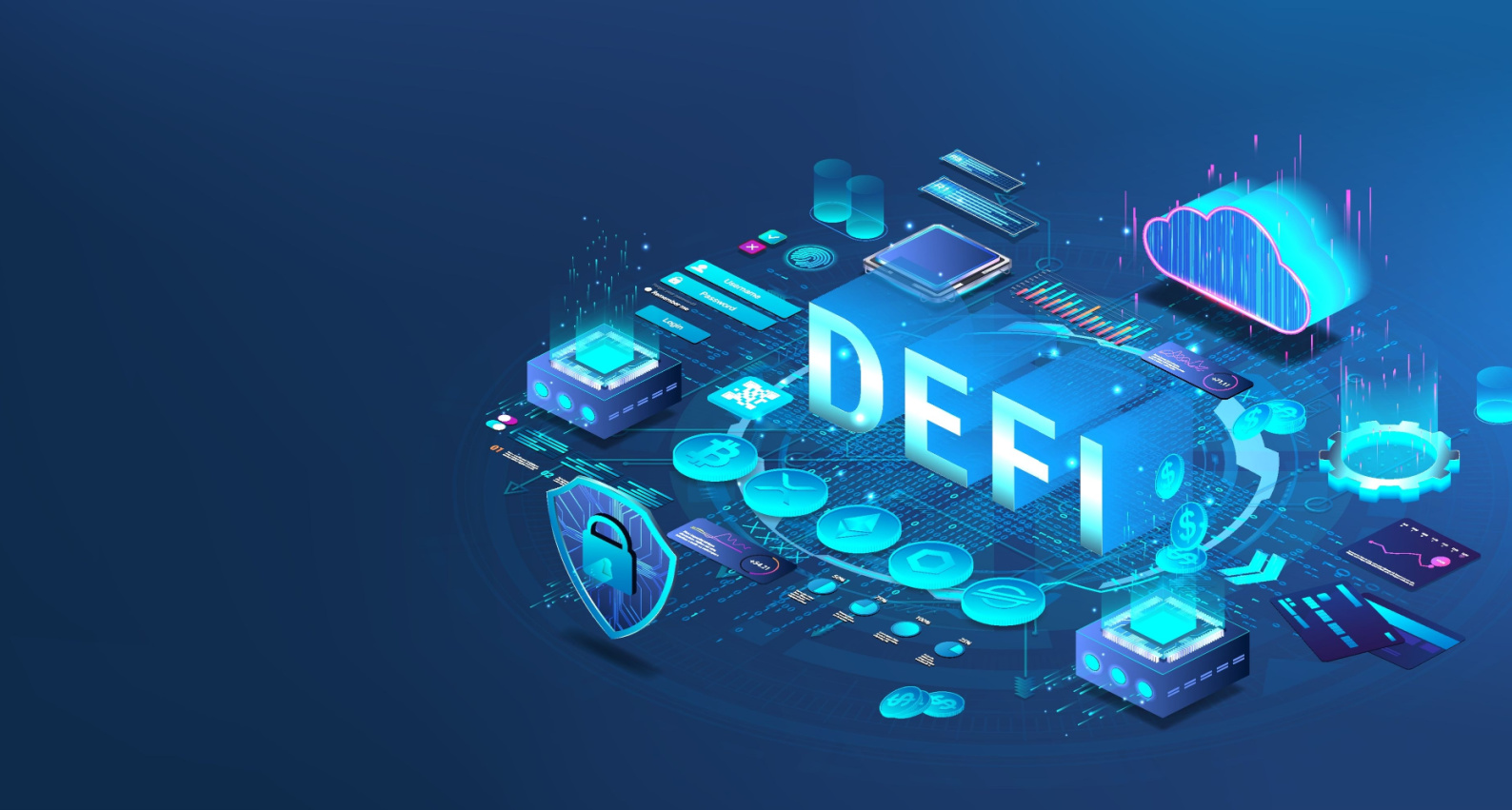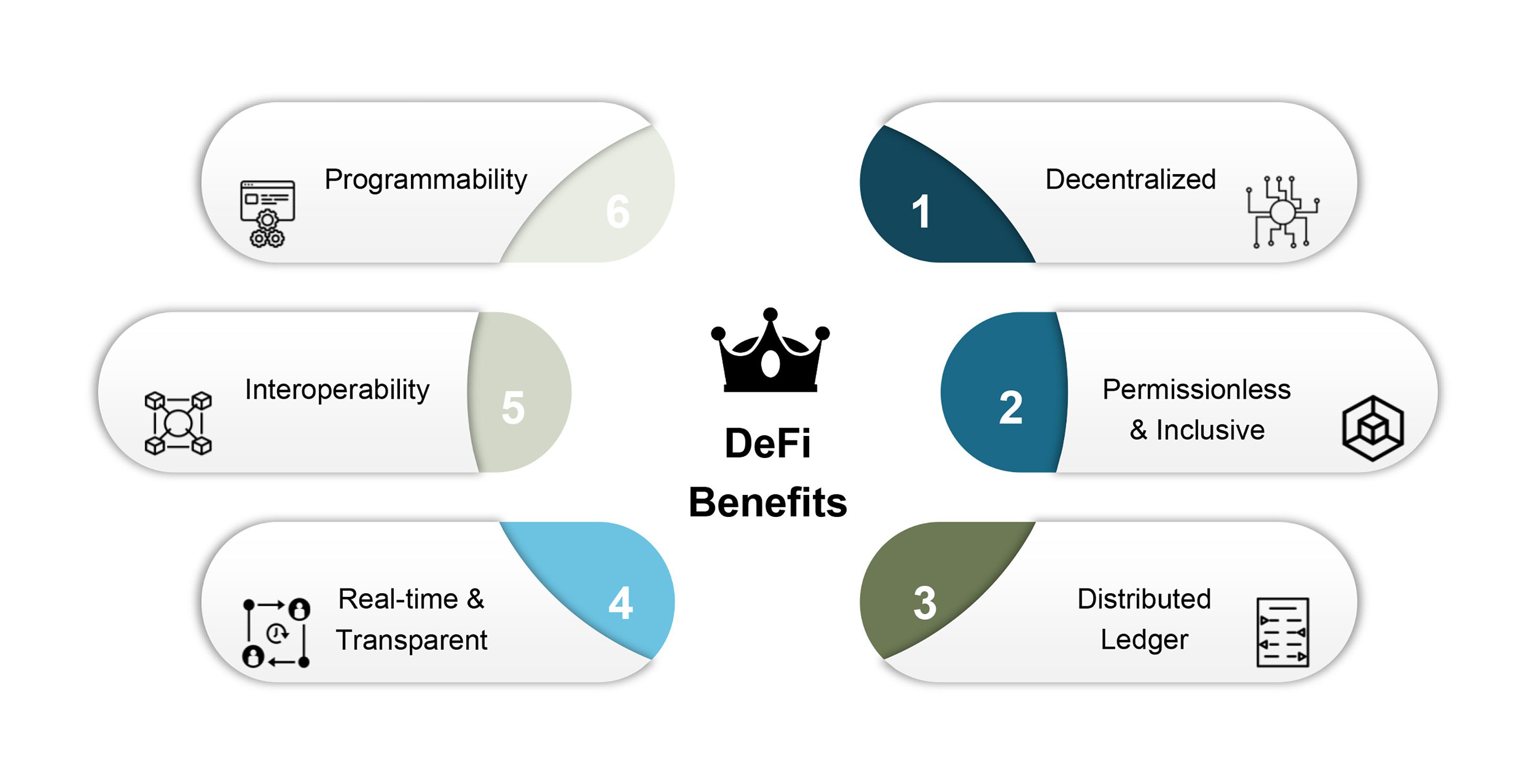DeFi – Revolutionizing Financial Markets
Published on 27 Sep, 2022

DeFi has made considerable progress in a surprisingly short time that would contribute to a more transparent and accessible future in finance due to rapid technological developments. There are now over 4.5 million DeFi users worldwide, which is anticipated to reach two-digit millions in the immediate future. However, the technology seems to be in a nascent stage and is yet to be fully stress tested at scale over an extended period. While there are concerns over DeFi replacing the traditional financial system, experts suggest they can coexist and thus improve the global finance architecture and benefit the economy worldwide.
DeFi is one of the emerging financial technologies established on secure distributed ledgers similar to those used by cryptocurrency and blockchain. In simple terms, DeFi is a P2P financial system that aims to eliminate the control banks and institutions have on money, financial products, and services.
A key phrase associated with DeFi is “smart contracts,” which are computer programs stored on blockchains that automatically get executed when the preset requirements are met. DeFi uses smart contracts to generate protocols that mimic existing financial services in a more open, transparent, and compatible manner.
DeFi platforms offer common services, including payments, loans, trades, investments, insurance, and asset management. The list is growing swiftly and gives a glimpse of a modern era of crypto-based innovation such as decentralized exchanges, synthetic assets, and flash loans.

DeFi Use Cases
- Data Analytics: Data analytics has undoubtedly become one of the most significant applications of DeFi in recent years. DeFi projects are anticipated to deliver considerable value in terms of analytics and risk management.
- Decentralized Autonomous Organizations (DAOs): DAOs are centralized financial institutions' counterparts, making them one of the pillars of DeFi use cases. Unlike centralized financial bodies, DAOs are decentralized and do not follow boundaries established by authorities.
- Asset Management: One of the most significant features of DeFi is that it gives users more control over their assets. Many of the most popular DeFi projects provide tools for users to manage their assets, such as purchasing, selling, and transferring digital assets.
- Infrastructure Tooling: Composability, a fundamental design principle of DeFi protocols, allows different components of a system to connect and communicate with one another. The concept of an integrated ecosystem is one of the most salient characteristics of DeFi.
- P2P Lending and Borrowing: The DeFi ecosystem is appropriate for P2P borrowing and lending. As traditional banking systems are becoming obsolete, the emergence of a lending and borrowing use case proves crucial. Several DeFi projects focusing on this use case have already entered the marketplace.
Benefits

DeFi offers various benefits for customers and investors such as eliminating intermediaries alongside centralized control and improving the accessibility of financial markets to institutional investors. DeFi would also work on creating new investment opportunities that can further assist in taking the concept to higher levels.
The decentralization approach can be effective for democratization of finance and banking. DeFi is permissionless and inclusive. Furthermore, it allows users to trade and move assets anywhere without having to pay any bank charges.
Anyone with a crypto wallet and internet connection can access DeFi services, regardless of where they are. The permissionless nature of its applications could also use blockchain's interoperability feature. In addition, the blockchain architecture ensures DeFi data is secure, tamper-proof, and auditable.
DeFi transactions happen in real time and are transparent. The underlying blockchain is updated once a transaction is completed, and interest rates are updated several times within a minute. Furthermore, every transaction on the Ethereum blockchain is broadcast to and confirmed by other users on the system.
Disadvantages
Most of DeFi problems and risks are primarily associated with related technologies. The challenges with blockchain are generally responsible for hampering the penetration of DeFi.
DeFi technology is still considered immature and yet to be fully stress tested at scale over an extended period. Funds may be lost or put at risk. Recently, DeFi platform Compound faced a major glitch where customers were accidentally sent millions of crypto dollars.
Users have limited or no protection in the DeFi space, as the technology is not covered by any state-run reimbursement scheme, and there are no laws in place to administer and regulate capital reserves for DeFi service providers.
There are concerns over the uncertainty and liquidity of DeFi projects and blockchain protocols. In the event of instability in the blockchain hosting of a DeFi project, the project could automatically inherit instability from the host blockchain.
DeFi projects encounter daunting difficulties in the scalability of the host blockchain from various perspectives. Furthermore, DeFi transactions could become extremely expensive during the congestion period and may require a considerably long time for authorization.
How does DeFi differ from traditional financial systems?
In centralized finance, the money is held by banks and corporations whose primary goal is to make money. The financial system has third parties that enable money movement, each charging fees for using their services.
Decentralized finance eliminates intermediaries by permitting people, merchants, and businesses to conduct financial transactions through a P2P financial network that uses security protocols, connectivity, software, and hardware innovation.
DeFi uses this technology to eliminate centralized finance models by allowing anyone to use financial services anywhere, regardless of who or where they are. Moreover, DeFi applications give users control over their money through personal wallets and trading services.

Impact on traditional banking system
The notion of a new technology seeking to displace established institutions and conventional ways of transactions was not well received by financial authorities. However, the financial landscape is being disrupted, and the industry should consider DeFi as a long-term business model.
Banks were initially skeptical about blockchain and the adoption rate was modest. However, with countries such as Canada, China, and the UK exploring a central bank digital currency, it is bound to take off. Financial institutions must understand that DeFi is a natural ecosystem and is here to stay. We already see proof of concepts and collaboration in this space, as ING Bank (Netherlands) analyzed the risks and opportunities associated with exploring the DeFi space.
Experts suggest DeFi and traditional financial systems can coexist, benefiting the broader economy. Banks must proactively adopt DeFi by generating novel DeFi propositions and engage with policymakers to explore how to regulate those schemes while maintaining DeFi's decentralized characteristics.
Banks can start offering DeFi services for unserved markets. Simultaneously, they should modify their internal compliance routines to connect their banking services and the larger fiat economy to all the opportunities that DeFi can provide. It is crucial for the banks to look at DeFi from an innovation perspective.
How is it shaping the future?
DeFi is still in its early stages of evolution with the system being unregulated, meaning it is still riddled with infrastructural mishaps, hacks, and scams. Many questions must be answered before DeFi becomes safe to use.
It is important to note that banks may not let go of their primary means of making money. If DeFi succeeds, it is highly likely that banks would find ways to get into the system—if not to control how money is accessed, then at least to make money from the system.
Market demand for DeFi is soaring, as locked-up assets surged from less than USD1 billion in 2019 to over USD200 billion within two years, attracting over one million investors in the process. The DeFi market is projected to reach USD800 billion over 2022–23 as more and more institutional investors are venturing into the industry.
Conclusion
Although DeFi has become popular in a short period, it has a long way to go in order to be a part of our daily lives. Some might opine that the benefits of DeFi outweigh its drawbacks, but major issues such as security and scalability must be addressed before its full-scale implementation. DeFi's blockchain-based ideas are expected to become embedded in the basic architecture of global finance. The technology is here to stay in the long term, with many experts suggesting it can coexist with traditional financial systems, thus benefiting the economy and its financial landscape.
